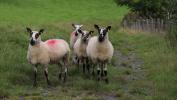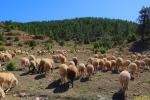GEN3OVI Operational Group: Validation of the effects of genetic variants associated with prolificacy and seasonality in Aragonese rust and bilbilitana rust
- Type Operational group
- Status In progress
- Execution 2023 -2026
- Assigned Budget 150.000,00 €
- Scope Autonómico
- Autonomous community Aragón
- Main source of financing CAP 2023-2027
The general objective is the implementation and validation of innovations in the field of sheep genetic improvement that allow for the improvement in the productive efficiency of farms of the native sheep breeds Rasa Aragonesa and Roya Bilbilitana to improve their sustainability.
Activities:
- 1.-Study of the genotypic frequencies of new gene variants associated with prolificacy (Grivette and G alleles of the BMP15 genes and SNP rs403578195 of the LEPR gene, respectively), and seasonality (GDO and T alleles of the SNP rs596133197 of the MTNR1A and LEPR genes, respectively) in two study populations of Rasa Aragonesa and Roya Bilbilitana.
- 2.-Determination of the effect of the different genetic variants of the 4 SNPs on reproductive traits: prolificacy, reproductive seasonality and sexual precocity in Rasa Aragonesa and Roya Bilbilitana.
- 3.-Determination of the effect of the different genetic variants of the 4 SNPs on productive traits: birth weight, weaning weight, average daily growth, and perinatal mortality in Rasa Aragonesa and Roya Bilbilitana.
- 4.-Study of possible interactions between phenotypes and genotypes
- Focus on maintaining local breeds with a strong rustic character that guarantee optimal adaptation to the environment.
- Incorporate the necessary characteristics that improve competitiveness through efficiency.
- Promote greater control and monitoring of the information necessary for the future of livestock farming
- Strengthen the improvement of less intensive breeds through individual and precision genetic selection thanks to advances in molecular genetics and early trait selection systems.
- Study of the genotypic frequencies of new gene variants associated with prolificacy (Grivette and G alleles of the BMP15 genes and SNP rs403578195 of the LEPR gene, respectively), and seasonality (GDO and T alleles of SNP rs596133197 of the MTNR1A and LEPR genes, respectively) in two study populations of Rasa Aragonesa and Roya Bilbilitana.
- Determination of the effect of the different genetic variants of the 4 SNPs on reproductive traits: prolificacy, reproductive seasonality and sexual precocity in Rasa Aragonesa and Roya Bilbilitana.
- Determination of the effect of the different genetic variants of the 4 SNPs on productive traits: birth weight, weaning weight, average daily growth, and perinatal mortality in Rasa Aragonesa and Roya Bilbilitana.
- Study of possible interactions between phenotypes and genotypes
Among the innovations that have had the greatest impact on meat sheep farming are those implemented by the Genetic Improvement and Selection Programs through the herd books of the various native breeds, as their proper management affects indicators of great influence on the operating results, such as fertility, prolificacy, and lamb mortality.
These genetic advances not only provide economic benefits, but also tools that allow, through Marker-Assisted Selection (MAS), to leave as future breeders animals with resistance alleles to diseases such as Scrapie or mastitis, or those that have variants associated with an increase in fertility or prolificacy, ensuring the maintenance of hardiness genes necessary in extensive livestock farming and that are a source of biodiversity that we must conserve.
Other genes, not studied so far and whose effects need to be validated, will provide improving characteristics not only in the area of productivity but also in environmental conservation, avoiding the use of hormonal products by selecting more fertile animals during periods of reproductive anestrus (RGL5).
Implementation and validation of innovations in sheep genetic improvement that allow for improved production efficiency on farms with the native Rasa Aragonesa and Roya Bilbilitana sheep breeds, enhancing their economic, environmental, and social sustainability.
- Coordinator/entity name: UPRA (UNION OF PRODUCERS OF THE "RASA ARAGONESA" BREED)
- Postal address: Camino Cogullada 65, Calle G, Pastores Building, Mercazaragoza, 50014 Zaragoza
- Coordinator/entity email: upra@oviaragon.com
976138050 – 902138050
Among the innovations that have had a major impact on meat sheep farming are those implemented through genetic improvement and selection programs, using herd books for the various native breeds. This is due to their sound management and impact on indicators that greatly influence farm performance, such as fertility, productivity, and lamb mortality. These genetic advances not only provide economic benefits but also tools that allow, through marker-assisted selection (MAS), the production of future breeding animals with alleles resistant to diseases such as scrapie or mastitis, or with variants associated with increased fertility or prolificacy. This ensures the maintenance of the hardiness genes necessary for extensive livestock farming, which constitute a source of biodiversity that we must conserve. Other genes, not yet studied and whose effects require validation, will provide characteristics that improve not only productivity but also environmental conservation, avoiding the use of hormonal products through the selection of more fertile animals in reproductive anestrus (RGL5).
- UPRA (UNIÓN DE PRODUCTORES DE LA RAZA "RASA ARAGONESA")
- ASOCIACION DE GANADEROS DE OVINO RAZA ROYA BILBILITANA (direccion@oviaragon.com)
- UPRA (UNIÓN DE PRODUCTORES DE LA RAZA "RASA ARAGONESA")







